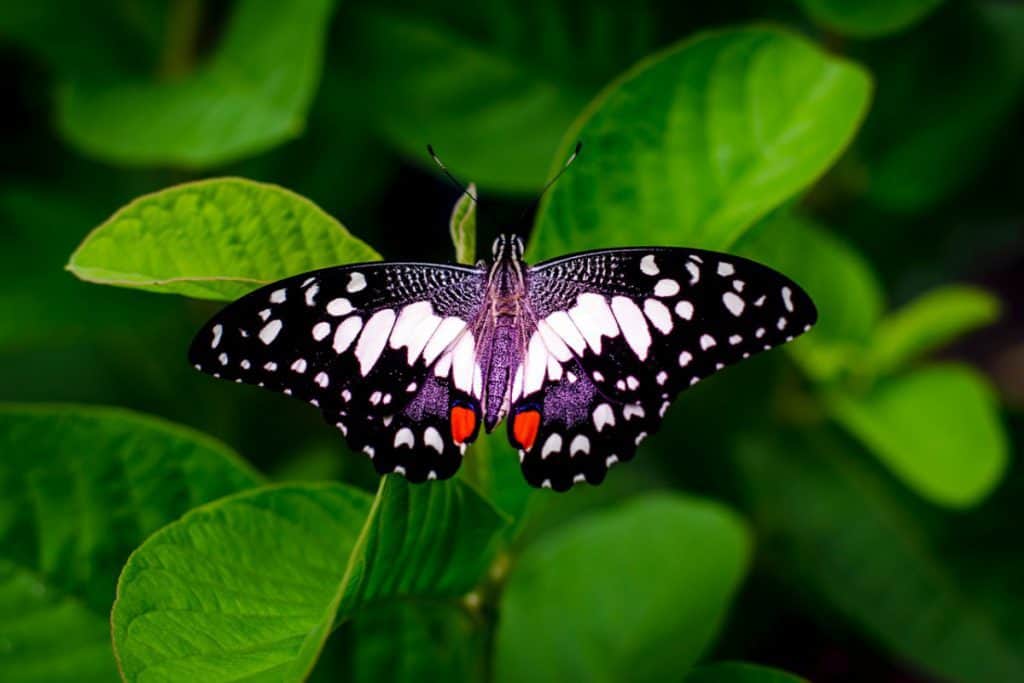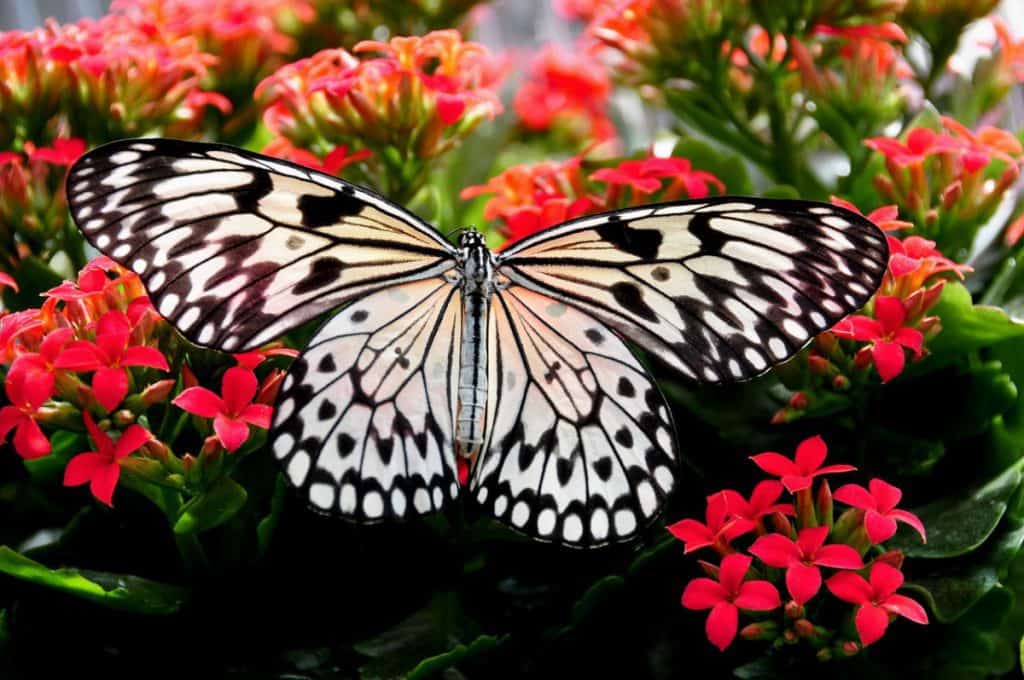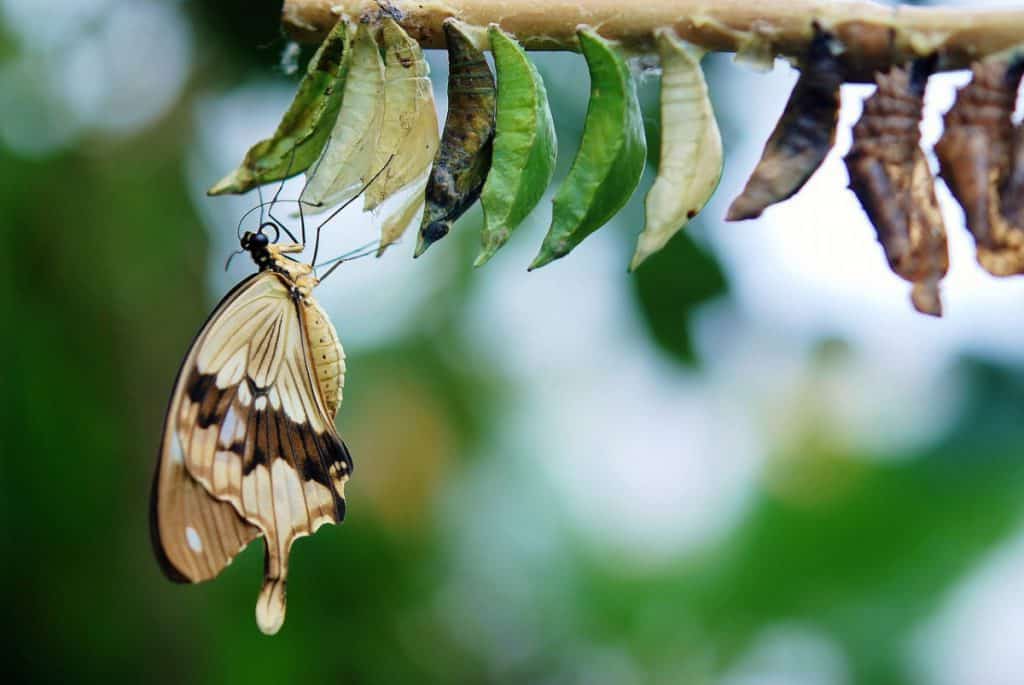
If you enjoy reading this article, why not check out our articles on How Long Do Ants Live? The Complete Answer and What Can Spiders Chew and Bite Through?
Do butterflies have good eyesight?
If you look very closely at a butterfly (or rather, a close-up photo), you’ll notice that all butterflies have two large eyes. Each eye appears huge in relation to their head, taking up almost the whole side of it.
But, you’ll also notice that those eyes don’t look anything like human eyes. For starters, there are no eyelids, no pupils, nothing… Butterfly eyes look just like two huge blocks. This might lead us to ask – can butterflies see very good at all?
The answer is yes, they absolutely do. It is believed butterflies sense colors better than any other species.
Scientists have studied butterflies and their vision for long enough to determine that not only butterflies can see color, but that they can experience it way better than we can.
Butterfly Vision vs Human Vision
But what do butterflies actually see? This is a difficult question to answer, as we obviously cannot go ahead and ask a butterfly about the way the world looks like to them.
The way that scientists went about this question is by delving deep into the physiology of the butterfly (and their eyes, more specifically), to understand what colors they can truly see.
This, however, didn’t make the question very easy to answer either. Scientists found out that, yes, butterflies see color. And not only that, but they are capable of seeing more colors than we do.
In other words, butterflies have body parts that allow them to see colors we, as humans, cannot perceive. For this reason, it’s very difficult to describe the vision of a butterfly. The colors that they can see might be unimaginable to us, since we’ve never seen so many colors – we simply don’t have eyes equipped with that ability.
But, to better understand this topic, we need to stop for a moment and understand how eyes actually work to allow us to see colors.
How does seeing colors actually work?
When you experience colors, your eyes are actually perceiving different light wavelengths and not the colors themselves. Your brain decodes that information into what you see, different colors.
Humans can perceive wavelengths ranging from 400 nm to 700 nm. These wavelengths include everything from violet at the lowest frequency to red at the highest frequency. There are also blue, green, yellow and a few others that are in between.
Butterflies, on the other hand, perceive lower wavelengths than humans do giving them the ability to perceive ultraviolet light.
However, it’s not just about the wavelength. Another important feature setting butterflies apart from humans is the number of light receptors their eyes contain.
Humans, like most species, have three types of photoreceptors. Each one for a different primary color: Red, green and blue. As a result, all the colors we see are actually a combination of these three colors. You might have heard of primary colors – which are also red, green, and blue, exactly for this reason. In painting and color studies, it is well known that by mixing these 3 colors you can make up all other colors. And that’s how our vision also works, only in real time.
On the other hand, butterflies can have up to fifteen different types of photoreceptors.
Each of these receptors might fire up for a color we know (for example, three of them might work to perceive the color green and other two for blue) and others might be there for colors we’ll never get to see. This means a butterfly not only sees color, but they perceive more colors than we do and they do it better than us.
Scientists believe their sight evolved this way as butterflies are extremely dependent on their vision for almost everything: from feeding to sex to survival. How well they can perceive their environment is crucial for a butterfly’s existence.
How do butterflies see color?
As you’ve already noticed, butterflies have a completely different set of eyes compared to humans. Most insects do.
Humans, for example, have two lenses, one per each eye. And three types of photoreceptors in each eye.
Butterflies have hundreds of tiny lenses with six sides each, per eye. Each tiny lens is working with a long tube called ommatidium. And every ommatidium has dozens of photoreceptors working to perceive different light wavelengths.
Even though Hollywood’s portrayal of insect vision might lead you to believe a butterfly might see dozens of tiny images through the same eye, they have the same vision (in a way) as humans do. One big image is perceived through their eyes, even though they have hundreds of lenses. The difference between how humans and butterflies experience their visual senses is how they perceive color, depth and how wide their field of vision is.
If you want to learn more about the eyesight of other bugs, you may be interested in reading How Do Ladybugs See?
Do all butterflies see color in the same way?

No, they do not. Their vision range varies almost as much as how many butterfly species there are. Even though they might all look similar to us, there are over 17000 butterfly species in the world right now. And they each experience the world differently! Most of them, if not all, have better color vision than humans.
Most humans have three types of photoreceptors to deal with color. Some humans have only two working photoreceptors (color blind people) and others have four (tetrachromats). Tetrachromats can’t sense UV light, though, but experience the colors we see more vividly.
So, humans typically have 3 types of photoreceptors, in rare cases they can have 2 or 4. In butterflies, there is a much wider range of possibilities. They can have anywhere from 6 to 15 receptors in their eyes.
The butterfly with the best vision known so far has as many as 15 receptors. It’s species found in Asia and Australia called the Common Bluebottle or the Blue Triangle (Graphium sarpedon), Humans with three photoreceptors in their eyes can perceive millions of color variations. We can only imagine the subtleties butterflies can see and experience with fifteen different photoreceptors.
Of course, fifteen types of photoreceptors are rather uncommon in most butterflies. Most butterfly species have six of them, which is more than enough to help them deal with their everyday activities. One more type of photoreceptor adds an incredible amount of possibilities color-wise. We can only imagine how much they can get with twelve more than humans.
Male and Female Butterflies Sometimes See the World Differently
Interestingly, in some species, make and female butterflies have different color receptor cells. For example, in the case of the Small White Butterfly (Pieris rapae), only females have photoreceptors for the color violet. Instead of the violet, it appears that males see an extra shade of blue, as they have two types of photoreceptors for blue. This phenomenon is called sexual dimorphism. And from the studies there are so far on these rare cases, it seems that female butterflies have better vision. Another example is the Sulfur Butterfly (Colias erate) where females have three types of different receptors for red, while males only have one.
What color spectrum do butterflies see?

As you know by now, not every butterfly experiences their vision in the same way. But all of them are a combination of six different spectrums.
The first three are the most common amongst insects and animals alike: Red (R), Blue (B) and Green (G). The fourth one is common amongst a few animals and insects, like birds or bees: Ultraviolet (UV) light. The fifth one is less common, the Violet (V). And finally, one that is almost exclusive to most butterflies is the Broadband (BB).
The last one is incredibly special. The BB photoreceptors are not designed to perceive one color, but multiple colors at once. The BB receptor catches different wavelengths instead of seeing one single color. Unfortunately, there is no way to understand how that would be perceived, as humans are incapable of doing that.
Can butterflies see ultraviolet light?
Yes, they can. Like many other insects -like bees- or other animals -like birds-, butterflies can sense and see ultraviolet light (also known as UV light). This trait helps butterflies communicate with each other (for example, looking for a sexual mate) or help them find food (as flowers tend to change colors only perceptive to those who can see UV light when they are filled with nectar or emptied out).
Can butterflies see in the dark?
Even though there are a lot of studies performed to understand how butterflies see and perceive colors, there are not many studies performed in regards to whether they can use their special eye abilities to see in the dark.
Most likely, butterflies are not equipped to see in the dark as well as other animals do, like owls. This is due to their diurnal lifestyle, similar to humans, they stay up during daylight and sleep at night.
Want to know if spiders can see in the dark?? Lucky for you, we’ve got an article on that! Can Spiders See in the Dark
Is there something butterflies cannot perceive with their vision?
There is nothing a butterfly can’t see in their field of vision. What they cannot do is look back. Unfortunately for them, butterflies can’t see their own wings. When it comes to their field of vision, they have a completely different visual experience as we do. They might be able to see more colors than we do and perceive types of lights we can’t, but there is a catch. As you know, butterflies do not share the same eye structure as humans. Instead of one lens, they have hundreds of them per eye. This makes it impossible for butterflies to focus on the image they are seeing.
Instead of seeing things clearly like humans do butterflies see in a rather pixelated way. A butterfly field of vision is always blurred. Because they have hundreds of lenses on top of their ommatidia, it would take an incredible amount of energy to focus it all on one point. Instead, they have a greater field of vision -to watch out for predators, for example- but they can never focus it on one thing alone. As a result, everything is blurrier but their field of vision is broader. But it’s a rather colorful blur.
Also, butterflies can’t see depth. That is something that comes very naturally to us, so we don’t even think about it. But butterflies can’t really see how far things are like we do. This is because our vision is binocular while that of butterflies is monocular.
The difference is, again, in the number of lenses. As we mentioned, human eyes have two lenses, and our brain combines the vision from both eyes at the same time to create an image of depth. The key thing is this process is the fact that the things we see with our two eyes overlap to an extent, which allows the brain to combine the two images.
On the other hand, butterflies have eyes on the sides of their heads. That gives them a greater field of vision, but the two images never overlap and there is no common focal point based on which depth could be determined.
Why did butterflies evolve to be this way?

There is no certain way to know why did butterflies develop the traits related to their vision. Whether it is their blurred but more active field of vision or the colors they can see. But the reasons are probably to how they can use these traits.
When it comes to their blurred vision, butterflies can have a more active field of vision and watch out for possible predators. If they had a more focused, reduced vision they would be attacked by their common predators and not see it coming.
When it comes to perceiving more colors (including UV light), it’s probably related to how they mate and search for food. Even though we can only see all butterflies as the same or almost lookalikes, if we could perceive UV light, we could see how they all differ from each other. Butterflies use the UV light on their wings to communicate with each other whether they are looking to sexually reproduce or not. They also use their ability to perceive colors more vividly to look for the right flowers to feed off to, as flowers change color as they become filled with nectar or are emptied out.
Can they see the same as humans?
No, absolutely not. Butterflies see the world in an entirely different way than humans. It comes as no surprise, as their eyes are completely different. Each one of them has good things going on for their vision, regardless. Humans can focus on objects and see far away more clearly than butterflies. While butterflies see things in a blurred kind of way, they can see more colors and experience the subtleties about them more vividly. They also see UV light, something impossible for humans. Even tetrachromats, humans with four types of photoreceptors can sense UV light as butterflies with four types of photoreceptors do.
Do any other species share the same vision capacity?
No, there are no species that can rival the butterfly’s color perception. There are similar ones, like the bees, who have developed a similar color perception but they also are missing part of it. For example, they have UV light perception but most bees cannot see the color red.
If you enjoyed reading this article, why not check out our articles on Are All Ladybugs Girls? and Do Ladybugs Build Nests?
References
Chen P, Stewart F and Arikawa K (2018) The More, the Better? A Butterfly with 15 Kinds of Light Sensors in Its Eye. Front. Young Minds. 6:70. doi: 10.3389/frym.2017.00070
Arikawa, K. (2017). The eyes and vision of butterflies. The Journal of physiology, 595(16), 5457-5464.
Recent Posts
Tiny Black Bugs in Bathroom NO WINGS: What They Are and What to Do!
Finding tiny black bugs in your bathroom can be uncomfortable, to say the least. Especially if they are persistent, or they appear in very large numbers, which they often like to do. When it...
Tiny Black Bugs in Plant Soil - What Are They & What To Do About It
A short horror story: You get a new houseplant. You do your best to take care of it. You’ve ensured that it has the right soil, the right amount of sun, it gets enough water. And then one day, you...

